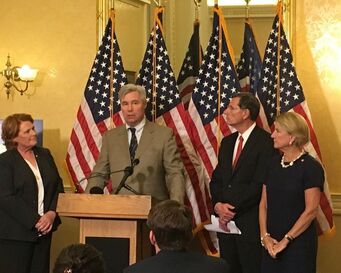
Over the last 20 years, a once eyebrow-raising technology has accelerated from the margins to the mainstream. We’re speaking, of course, about renewable energy. The story for carbon capture has looked a little different. Recently, advocates for the technology have been repelling waves of naysayers, all while holding out for a big break. For wind and solar, that break came in the form of federal tax credits in the 1990s that helped incentivize their use. Those investment and production credits also helped shift public perceptions, and adoption has since taken off.
Hope for carbon capture came in February of 2018, when the US put a new price on the technology. The changes were slipped into a spending bill to avert a government shutdown. In the ensuing weeks, news stories churned out a few refrains: the coalition backing the bill was unusually broad (true), the technologies in question are expensive and unproven (mostly true), and the tax credits will hopefully do for carbon capture what those other ones did for renewable energy (fingers crossed). The bill also triggered some initial enthusiasm over the unlikely truth that a tax policy enacted during the Trump presidency could help address climate change. But the excitement has since died down, and the slow work of project development has begun. For this work to really take off, industry and civil society need to understand the actual mechanics of the credit - not just the general, long-term predictions. A closer look at the tax credits should help clarify just how they work and what they’re poised to do.
Hope for carbon capture came in February of 2018, when the US put a new price on the technology. The changes were slipped into a spending bill to avert a government shutdown. In the ensuing weeks, news stories churned out a few refrains: the coalition backing the bill was unusually broad (true), the technologies in question are expensive and unproven (mostly true), and the tax credits will hopefully do for carbon capture what those other ones did for renewable energy (fingers crossed). The bill also triggered some initial enthusiasm over the unlikely truth that a tax policy enacted during the Trump presidency could help address climate change. But the excitement has since died down, and the slow work of project development has begun. For this work to really take off, industry and civil society need to understand the actual mechanics of the credit - not just the general, long-term predictions. A closer look at the tax credits should help clarify just how they work and what they’re poised to do.
So, what happened?
In 2014, a group of lawmakers, led by Sen. Heitkamp (D-ND), began efforts to reform the tax credit. Known as “45Q” for where it lives in the tax code, the earlier version was intended to facilitate two types of carbon capture: enhanced oil recovery, in which carbon dioxide is pumped into aging oil reservoirs to recover more oil, and underground storage. Back then, credits came in at $10 and $20, respectively, with a cap at 75 million tons of CO2. This last proviso had unintended consequences. With construction for carbon capture projects taking a while to ramp up and costs typically running high, the cap did not provide enough long-term financial certainty: it was unclear if credits would continue to flow once a project was underway. In light of this and other short-sighted features, credits could not be easily transferred, while their small value didn’t exactly tip projects into the black, the credits did little to spur adoption.
The push for reform entered a new phase in 2016 with the introduction of the Carbon Capture Utilization and Storage Act. It did away with the cumulative cap on credits in favor of a defined time period for claiming them. The bill re-appeared in 2017, now called the FUTURE Act (Furthering carbon capture, Utilization, Technology, Underground storage, and Reduced Emissions Act). The acronym stuck, but the bill didn’t advance until it was rolled into the Bipartisan Budget Act of 2018, a must-pass bill to prevent a shutdown. To casual observers, the provisions of the FUTURE Act might have seemed last minute and the mixed backing unexpected. In reality, its successful passage largely owed to the continuous advocacy of the Carbon Capture Coalition. This coalition of organized labor, coal companies, oil companies, and environmental groups was able to effectively message to both political parties. When the ink dried, the bill had 24 co-sponsors in the Senate.
Here’s what you should know
Headlines have focused on the increased tax credit value, but the reform is much more comprehensive. The original credit failed only in part due to its low credit value: the cap created financial uncertainty, and the lack of transferability made it difficult to monetize for entities without tax liability. Here are seven characteristics of the tax credit critical to understanding how it will be used in the future:
- It’s a tax credit, not a tax deduction. It’s worth clarifying: tax credits reduce your tax bill dollar-for-dollar, whereas deductions lower your taxable income. For most people, this makes tax credits more valuable. However, businesses with larger tax liabilities?—?like master limited partnerships and co-ops reap fewer benefits.
- This time, the credits are transferable. 45Q initially sends credits to the owner of the carbon capture equipment but allows them to be transferred to another company involved in handling the CO2. The details of this transfer will be the subject of new regulations that the Treasury Department will write in the coming months and years. Ideally, the transfer will be flexible and have a low burden for compliance.
- There are size requirements for eligibility, and they vary by emissions source and application of CO2. To claim the credits, fossil power plants must capture at least 500,000 metric tons of CO2 per year. For industrial facilities and direct air capture facilities, that threshold drops to 100,000. If those same facilities put the CO2 to work in carbontech (excluding EOR), minimum project size falls even further to 25,000 metric tons per year.
- Construction must begin by January 1, 2024. This time crunch is exacerbated by the fact that the ‘beginning’ is currently an undefined boundary line where carbon capture is concerned. On a positive note, six years is more headway than the solar tax credit gave projects to start construction (although that credit was subsequently renewed and extended).
- Credits can be claimed for 12 years. The clock starts ticking once operation begins. (This is longer than the 10 years over which the wind production tax credit can be claimed.) A minimum-scale industrial capture project capturing 100,000 tons per year would generate between $3.5 and $5 million a year or a lifetime credit value of $42 to $60 million. But the big money is in the power sector. A large-scale coal power plant capturing 90% of its 5 million tons a year would eke out a lifetime value of $1.89 to $2.7 billion.
- The credit value adjusts with time. Tax credits for enhanced oil recovery and carbontech increase linearly, from $12.83 in 2016 to $35 in 2026. Likewise, tax credits for saline sequestration increase linearly from $22.66 in 2016 to $50 in 2026. For all three use-cases, the credits will be indexed to inflation beyond that point.
- Carbontech requires a lifecycle analysis. Projects that use the credit for making products must demonstrate a favorable lifecycle analysis (LCA) under the Clean Air Act. But carbontech presents a unique challenge. While the lives of fuels all end in combustion, carbontech can make a host of products involving different processes and forms of disposal at end of life. This complicates the analysis and makes writing regulations defining that analysis methodology uncertain.
This article is part of a Carbon180 series on the legislative landscape of carbontech, a class of products and services that convert waste carbon into a variety of products using processes that create fewer emissions than standard alternatives.
This article also appeared in Medium.
This article also appeared in Medium.



